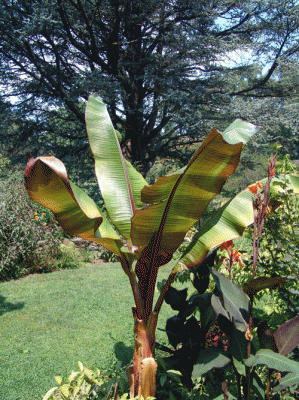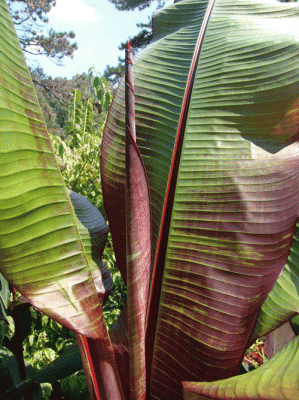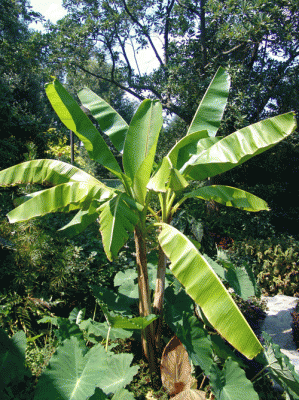Bananas at the Scott Arboretum
You need not travel to the tropics to see bananas growing and thriving. Over the last several years the Scott Arboretum has grown nearly a dozen kinds of bananas, including a couple species that are hardy in Swarthmore.
Without doubt my favorite banana is the red Abyssinian banana, Ensete ventricosum ‘Maurellii’. I have grown these at the Arboretum and in my home garden. A 4-foot tall banana planted in May will turn into a massive 10- to 12-foot tall bold-foliaged plant by the end of the summer. ‘Maurellii’ is selected for its ribbed, purple-blushed foliage with a striking red midrib on the leaf. This is the least hardy of the bananas we grow, but it will look attractive until a significant frost, usually occurring in early November.
Musa sikkimensis has a narrower and lighter green leaf with a red faint red midrib. Our plant, currently in the Entrance Garden, is about 8-feet tall. Like other bananas it grows best in full sun with supplemental water and regular feeding of a fertilizer high in nitrogen.
The hardiest of all the bananas in the Delaware River Valley is Musa basjoo. Charles Cresson who gardens in Swarthmore, has had one growing outside for over a decade. The Arboretum has a sizeable plant in the Cosby Courtyard. After the first hard frost in the fall we trim the long strap-like leaves back to the main stem. We then pile about 2 feet of wood chips around the base for extra insulation. Over the winter the stems look dead, but in May an individual leaf begins to unfurl. Over time the clump will get larger because of the side plants or “pups” that are generated around the edge of the plant. The plant in the Cosby Courtyard is now about 6 feet across and 12 to 14 feet tall.
The tender bananas like Musa sikkimensis and Ensete ventricosum ‘Maurellii’ are dug up in the fall. After the leaves have had frost and been cut back to the stem we lift the plant with a digging fork. Plants are placed in large black nursery containers and a small amount of mulch is placed around the bases. We set them in our cool, dark, damp basement for the winter where they sit quasi-dormant. The next spring we simply lift them out of the bucket and plant them in the ground. Within months, they create a phenomenal tropical display.








No Comments